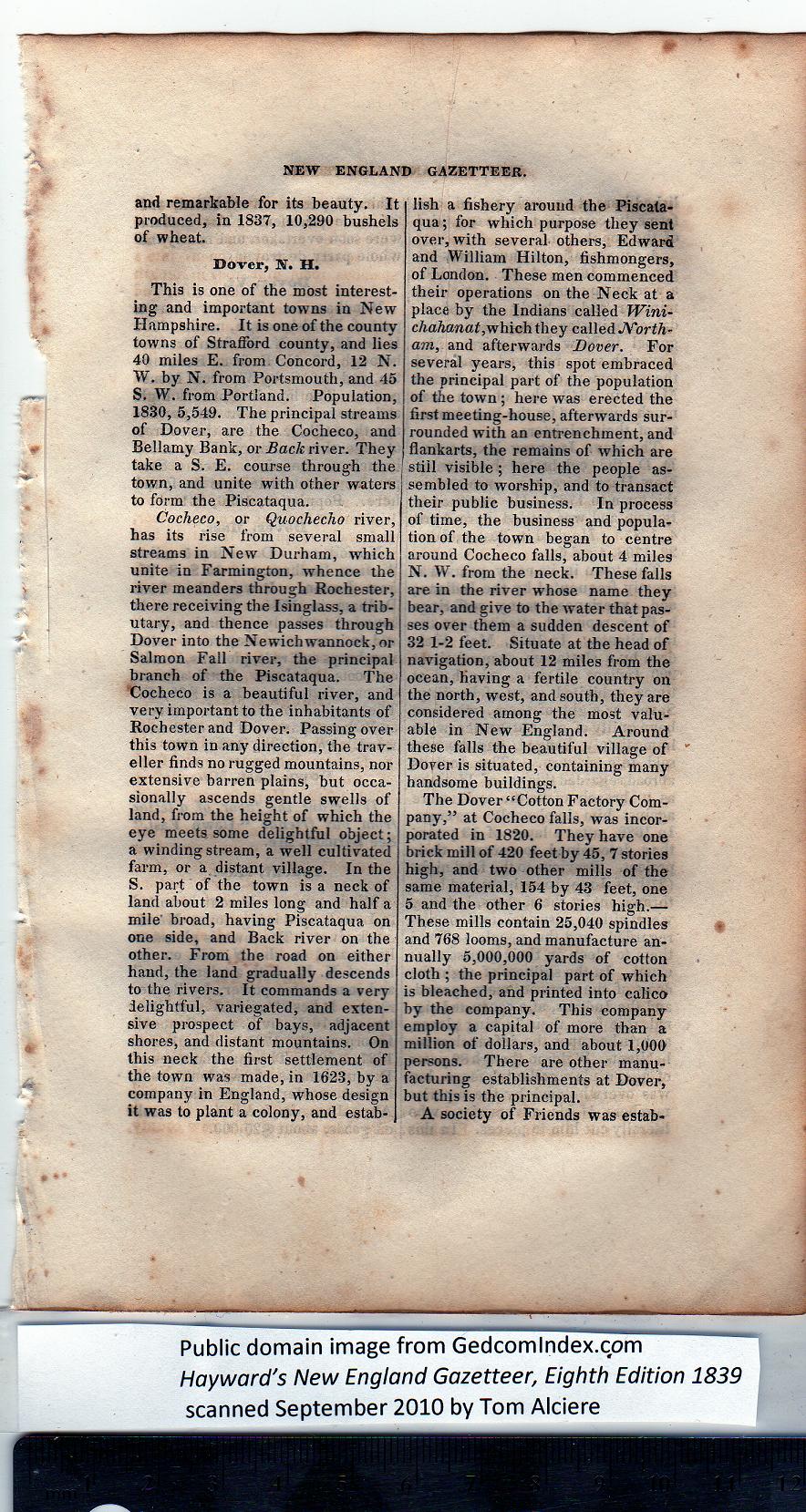|
and remarkable for its beauty. It
produced, in 1837, 10,290 bushels
of wheat.
Dover, N. H.
This is one of the most interest-
ing and important towns in New
Hampshire. It is one of the county
towns of Strafford county, and lies
40 miles E. from Concord, 12 N.
W. by N. from Portsmouth, and 45
S. W. from Portland. Population,
1830, 5,549. The principal streams
of Dover, are the Cocheco, and
Bellamy Bank, or Back river. They
take a S. E. course through the
town, and unite with other waters
to form the Piscataqua.
Cocheco, or Quochecho river,
has its rise from several small
streams in New Durham, which
unite in Farmington, whence the
river meanders through Rochester,
there receiving the Isinglass, a trib-
utary, and thence passes through
Dover into the Newichwannock, or
Salmon Fall river, the principal
branch of the Piscataqua. The
Cocheco is a beautiful river, and
very important to the inhabitants of
Rochester and Dover. Passing over
this town in any direction, the trav-
eller finds no rugged mountains, nor
extensive barren plains, but occa-
sionally ascends gentle swells of
land, from the height of which the
eye meets some delightful object;
a winding stream, a well cultivated
farm, or a distant village. In the
S. part of the town is a neck of
land about 2 miles long and half a
mile broad, having Piscataqua on
one side, and Back river on the
other. From the road on either
hand, the land gradually descends
to the rivers. It commands a very
delightful, variegated, and exten-
sive prospect of bays, adjacent
shores, and distant mountains. On
this neck the first settlement of
the town was made, in 1623, by a
company in England, whose design
it was to plant a colony, and estab-
lish a fishery around the Piscata-
qua; for which purpose they sent
over, with several others, Edward
and William Hilton, fishmongers,
of London. These men commenced
their operations on the Neck at a
place by the Indians called Wini-
chahanat, which they called .Worth-
am, and afterwards Dover. For
several years, this spot embraced
the principal part of the population
of the town; here was erected the
first meeting-house, afterwards sur-
rounded with an entrenchment, and
flankarts, the remains of which are
still visible; here the people as-
sembled to worship, and to transact
their public business. In process
of time, the business and popula-
tion of the town began to centre
around Cocheco falls, about 4 miles
N. W. from the neck. These falls
are in the river whose name they
bear, and give to the water that pas-
ses over them a sudden descent of
32 1-2 feet. Situate at the head of
navigation, about 12 miles from the
ocean, having a fertile country on
the north, west, and south, they are
considered among the most valu-
able in New England. Around
these falls the beautiful village of
Dover is situated, containing many
handsome buildings. |
The Dover “Cotton Factory Com-
pany,” at Cocheco falls, was incor-
porated in 1820. They have one
brick mill of 420 feet by 45, 7 stories
high, and two other mills of the
same material, 154 by 43 feet, one
5 and the other 6 stories high.—
These mills contain 25,040 spindles
and 768 looms, and manufacture an-
nually 5,000,000 yards of cotton
cloth ; the principal part of which
is bleached, and printed into calico1
hy the company. This company
employ a capital of more than a
million of dollars, and about 1,000
persons. There are other manu-
facturing establishments at Dover,
but this is the principal.
A society of Friends was estab- |
